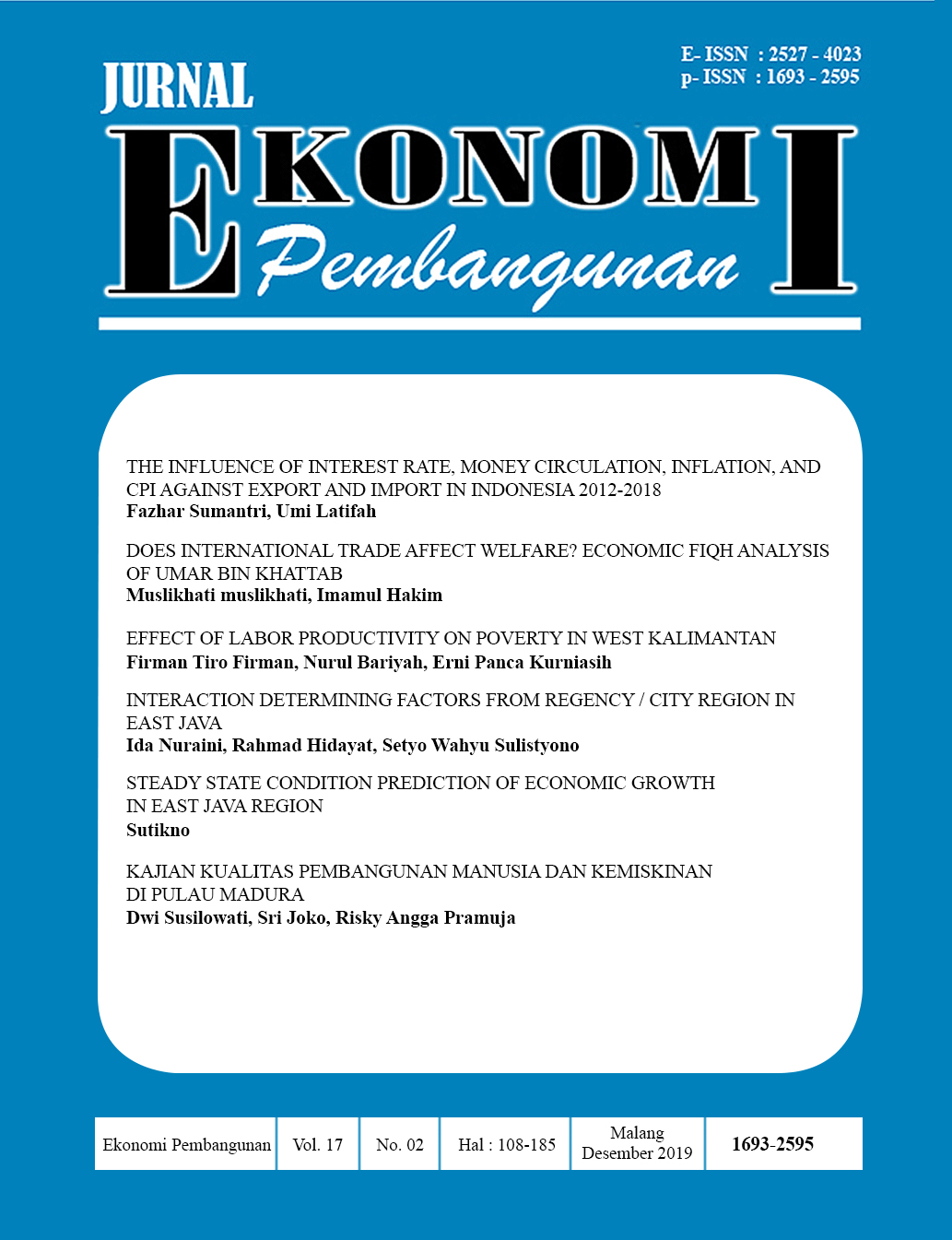INTERACTION DETERMINING FACTORS FROM REGENCY / CITY REGION IN EAST JAVA
DOI:
https://doi.org/10.22219/jep.v17i2.10998Keywords:
Economic, development, povertyAbstract
This study aims to calculate the strength of interaction between regions and determine the variables determining the level of interaction between regions. This research was conducted in the area of East Java province with the object of 39 regencies and cities using the variable mileage, educational facilities, and health facilities. The data used are secondary data sourced from the Central Statistics Agency of East Java, meanwhile the analytical tool used is gravity analysis and regression analysis, with the regression model used is panel data regression, the Random Effect model. The results showed that the areas in the interaction category were weak, namely the southern part of East Java, the western part and the eastern part while those in the interaction category were in the middle eastern part of Java. Category of regions with strong interaction are Gerbang kertosusila and surrounding areas. From the random effect model regression analysis it is known that the distance, education and health facilities variables together influence 95% of the level of interaction between regions and the most dominant variable is the distance between regions which has a regression coefficient of -62480222. Health facility variable has a significant positive effect while education facility variable has no effect on interactions between regions. Therefore, in order for equitable development to be realized immediately, the distance between regions must be shortened by improving the quality of roads, construction of new roads and toll roads, especially in the southern, eastern and eastern parts of Java.
Downloads
References
(BPS), B. P. S. J. T. (2018). Sektor Industri Pengolahan. Retrieved from https://jatim.bps.go.id/subject/9/industri.html#subjekViewTab3
Apriliani, N. K. D. S., & Bendesa, I. K. G. (2018). Analisis Disparitas Pendapatan Di Kawasan Pariwisata, Kecamatan Kuta, Kabupaten Badung. E-Jurnal EP Unud, 2, 208–215.
Bintarto dan Suprastopo. (1987). Metode Analisis Geografi. Jakarta: LP3ES.
Departemen Pekerjaan Umumu. (2006). Peraturan Pemerintah Republik Indonesia Nomor 34 Tahun 2006 Tentang Jalan. Badan Penerbit Pekerjaan Umum.
L. Muta’ali. (2015). Teknik Analisis Regional Untuk Perencanaan Wilayah Tata Ruang dan Lingkungan. yogyakarta: Badan Penerbit Fakultas Geografi Universitas Gajah Mada.
Liestiani, E. (2006). Pengaruh Aksesibilitas terhadap Wilayah Pelayanan Puskesmas di Kota Magelang Berdasarkan Persepsi Pengunjung. Wilayah Pelayanan Puskesmas Di Kota Magelang Berdasarkan Persepsi Pengunjung, Tugas Akhir, Jurusan Perencanaan Wilayah dan Kota, Fakultas Teknik, Universitas.
Muhamad Magribi, L. O. (2004). Aksesibilitas dan Pengaruhnya Terhadap Pembangunan di Perdesaan. Jurnal Transportasi, 4(2), 149–160.
Nuraini, I. (2017). Kualitas Pertumbuhan Ekonomi Jawa Timur. Retrieved from https://semnasunikama.ac.id/feb/unduhan/publikasi/1520846230.pdf
Priyadi, U. dan A. E. (2017). Identifikasi Pusat Pertumbuhan dan Wilayah Hinterland Di Propinsi Daerah Istimewa Yogyakarta. AJIE - Asian Journal of Innovation and Entrepreneurship, 2(2).
Putra, Mulhadi, dkk. (2017). Sektor Unggulan dan Interaksi Antar Wilayah Pada Kawasan Strategis Nasional Perkotaan Mebidangro. Jurnal Wilayah Dan Lingkungan, 5(3), 181-187.
Sudaryadi. (2007). Dampak Pembangunan Jalan Jalur Lintas Selatan Terhadap Output Sektor Produksi Rumag Tangga Jawa Tengah (Simulasi SESN Jawa Tengah 2004). Thesis MIESP UNDIP.
Widarjono, A. (2007). Ekonometrika Teori dan Aplikasi untuk Ekonomi dan Bisnis (Edisi Kedu). yogyakarta: Fakultas Ekonomi UII.
Downloads
Published
Issue
Section
License
Authors who publish with Jurnal Ekonomi Pembangunan (JEP) agree to the following terms:
- For all articles published in Jurnal Ekonomi Pembangunan (JEP), copyright is retained by the authors. Authors permit the publisher to announce the work with conditions. When the manuscript is accepted for publication, the authors agree to the publishing right's automatic transfer to the publisher.
- Authors retain copyright and grant the journal right of first publication with the work simultaneously licensed under a Creative Commons Attribution-NonCommercial-ShareAlike 4.0 International License that allows others to share the work with an acknowledgment of the work's authorship and initial publication in this journal.
- Authors can enter into separate, additional contractual arrangements for the non-exclusive distribution of the journal's published version of the work (e.g., post it to an institutional repository or publish it in a book), with an acknowledgment of its initial publication in this journal.
- Authors are permitted and encouraged to post their work online (e.g., in institutional repositories or on their website) before and during the submission process, as it can lead to productive exchanges and earlier and greater citation of published work (See The Effect of Open Access).

This work is licensed under a Creative Commons Attribution-NonCommercial-ShareAlike 4.0 International License.






















